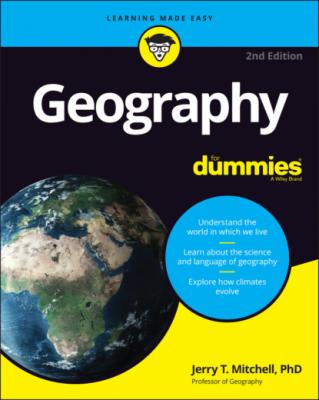ТОП просматриваемых книг сайта:
Geography For Dummies. Jerry T. Mitchell
Читать онлайн.Название Geography For Dummies
Год выпуска 0
isbn 9781119867142
Автор произведения Jerry T. Mitchell
Жанр География
Издательство John Wiley & Sons Limited
Case Study #2: Where Something Should be Located
Where should a gas station be located, and why? Those questions are central to our second case study.
Thinking geographically about where something should be located has many important and useful applications. For example, consider the occupational endeavors called planning. That includes urban planning, regional planning, and transportation planning, to name just three. All are intimately concerned with the question of where things should be located. The business world also provides lots of useful applications. Choosing a good location is often an important determinant of whether an enterprise succeeds or fails. The questions posed previously call for a business decision based on the process of thinking geographically.
In this case study, assume that you want to go into the gas station business. Therefore, your relevant geographic question is “Where should my gas station be located?”
Similar to the first case study, I’d love to have you go around town and acquire pertinent geographic information. That would include finding prospective sites for your gas station, and identifying the factors that appear to be contributing to the success of existing gas stations that clearly are doing a lot of business. The latter is important because it helps you choose the prospective site that offers the best chance for success. But that’s a bit much to ask. So once again, assume that the footwork has been done, that relevant geographic information has been acquired, and that it has been organized in ways that include a map (which happens to be Figure 2-2).
(© John Wiley & Sons Inc.)
FIGURE 2-2: Potential sites for a gas station.
The map shows two land parcels that are indicated by “A” and “B.” Assume each has an identical size, an affordable price, a busy thoroughfare alongside, and that other prospective sites for your gas station have been eliminated from consideration. Your final choice with be either “A” or “B.” Is one location clearly preferable?
Analysis of the geographical information indicates the two properties have one key difference: Property A is located on a corner lot, while Property B is in the middle of a block. Is that difference significant? Think about the location of every gas station you have ever seen. Is it on a corner or in the middle of a block? It’s almost always on a corner, isn’t it? And the main reason is that, on a daily basis, more cars (potential customers) pass by a corner lot as opposed to a middle-of the-block lot because the corner adjoins two roadways rather than one. In addition, corner lots are somewhat easier to enter and exit. Accordingly, the answer to your geographic question (Where should my gas station be located?) is lot A.
Summing up
In the process of choosing a location for your gas station, you have been thinking geographically once again. Only this time, however, you began by considering where something (a gas station) should be located. You then proceeded to acquire and organize (map) pertinent geographic information, analyze it, and answer the question.
Looking ahead
Chapter 3
Lining Up Locations
IN THIS CHAPTER
Back in 1992, a cargo ship lost a container and launched almost 29,000 bath toys into the northern Pacific Ocean. Plastic beavers, frogs, turtles, and ducks, all bobbing along, wave after wave. Dubbed “the Friendly Floatees,” these plastic toys — cute as they were — added to a growing ocean pollution problem. But they had one useful benefit, and that was to help model ocean currents.
As the toys washed ashore or were seen at sea, a very useful piece of information was collected: their location. To relay that information to others, humans have devised a number of ways to express location on Earth’s surface. In this case, the ducks and their friends were identified using latitude and longitude, a set of invisible lines and coordinates that describe where things are.
But how does this imaginary system work? Let’s visit Gridville to find out.
Welcome to Gridville
Welcome to Gridville, the cute little burg shown in Figure 3-1. You and I are going to pay this town a quick visit because it looks like a great locale to review basic concepts of location (latitude and longitude), the topic of this chapter. I say “review” because if you are like most people, then you probably learned about these things during elementary or middle school, but may have forgotten some or most of it later on.
(© John Wiley & Sons Inc.)
FIGURE 3-1: A map of Gridville.
Knowledge of latitude and longitude gives you basic location and orientation skills regarding our planet Earth. It also affords the opportunity to learn all sorts of little tidbits, which, in addition to impressing your friends, can greatly enhance your understanding of geography.
Feeling Kind of Square
To get started, look at Figure 3-1 and familiarize yourself with Gridville. In particular, note the following:
The roads are aligned with the cardinal directions — that is, they run north-south or east-west. The result is a grid pattern of north-south roads that intersect east-west roads at right angles. So, getting right with Gridville means getting used to a city that is all right angles and nothing but right angles. Thus, I’ll understand if this town leaves you feeling a little square.
North is toward the top of the map; south is toward the bottom; east is toward the right; and west is toward the left. This is a near-universal rule in map-making, but you should always carefully examine the map you are looking at and confirm which way is which.
Gridville has a principal east-west road named Equator Boulevard, and a principal north-south road named Prime Meridian Way. The two roads cross in the middle of Gridville.
Every other

